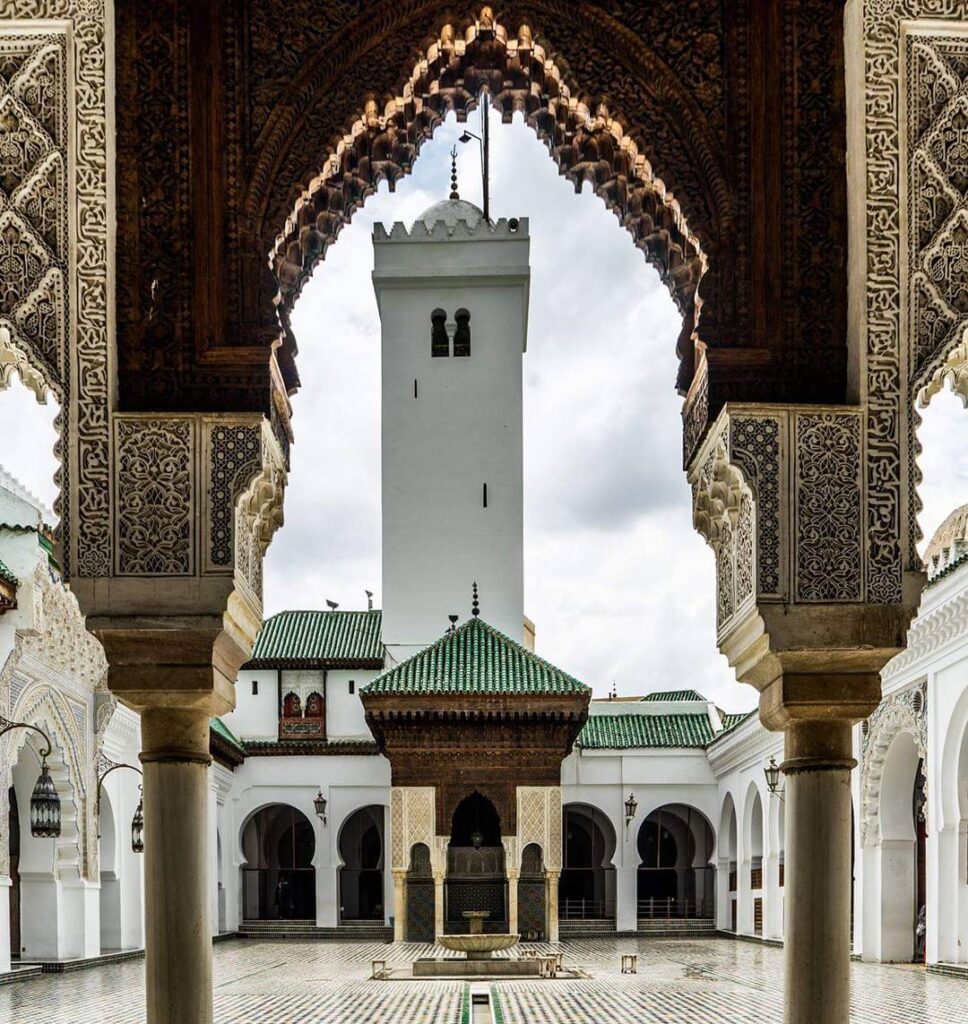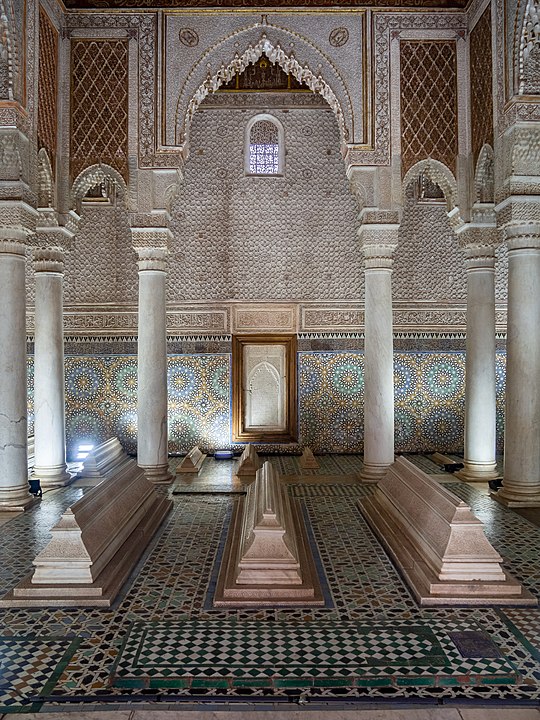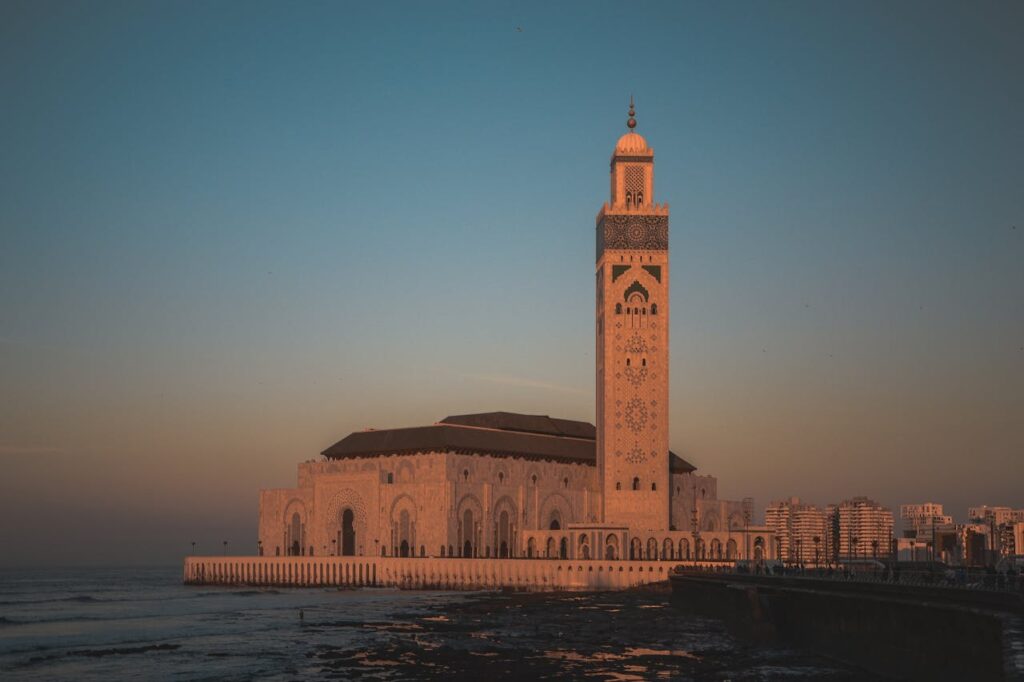Morocco: A Melting Pot of Dynasties and Cultures
Morocco’s rich tapestry of history is woven from the legacies of numerous dynasties and diverse cultural influences. The country’s historical narrative is marked by significant events and milestones that have shaped its identity and earned it international recognition.
Historical Dynasties
Over the centuries, several dynasties have ruled Morocco, each leaving an indelible mark on its cultural and historical landscape:
The Idrissid Dynasty: Foundation of Moroccan Royal Heritage (789-974; 1465-1472)
The Idrissid Dynasty, reigning from 789 to 974 and briefly from 1465 to 1472, was the first royal dynasty to establish dominion over Morocco, marking the inception of Moroccan statehood.
Founding and Expansion
The dynasty’s founder, Idriss I, is renowned for making Volubilis (Walili) his capital. From its inception, the Idrissid Dynasty rapidly expanded its control, dominating much of the Maghreb, including the region that constitutes modern-day Morocco. This period was pivotal in consolidating the foundations of the Moroccan state and Islamic culture in the region.
Major Developments
- Establishment of Fez: Under the reign of Idriss II, the dynasty founded the city of Fez, which later became the capital, succeeding Volubilis. Fez grew into a major cultural, religious, and economic center.
- Architectural and Religious Contributions: The Idrissids left a significant architectural and religious legacy. One of the most notable monuments from this era is the Al-Qarawiyin Mosque in Fez, an architectural masterpiece and one of the most important mosques in Morocco. The mosque, founded in 859, is also considered one of the oldest universities in the world.

Decline and Legacy
After more than a century of rule, the Idrissid Dynasty eventually fell to the Almoravids. Despite their decline, the Idrissids’ contributions to the development of Moroccan urban centers, religious institutions, and architectural heritage remain profound. The cities they established and the cultural advancements they initiated laid the groundwork for the subsequent dynasties that shaped Morocco’s rich historical tapestry.
The brief resurgence of the Idrissid Dynasty from 1465 to 1472, although short-lived, underscores the enduring legacy and influence of this foundational period in Moroccan history.
By examining the achievements and contributions of the Idrissid Dynasty, one gains a deeper understanding of Morocco’s early development as a unified state and its lasting cultural heritage.
The Almoravid Dynasty: Expanding and Unifying the Maghreb and Al-Andalus (1060-1147)
Following the decline of the Idrissid Dynasty, the Almoravid Dynasty rose to power, significantly shaping the historical and cultural landscape of Morocco and beyond. The Almoravids, a Berber Muslim dynasty, not only unified large swathes of the Maghreb but also extended their reach into Al-Andalus, leaving an indelible mark on the region’s history.
Founding and Expansion
The Almoravid Dynasty emerged in the early 11th century, with its foundations rooted in a religious and military movement. By 1062, the Almoravids had established the city of Marrakech, which would become their capital and a key center of power. Their expansion was marked by the conquest of various African realms before turning their attention northwards.
- Marrakech: Founded in 1062, Marrakech quickly became the dynasty’s capital and a significant imperial city. It served as a vital trading hub and a bridge between sub-Saharan Africa and the Maghreb. The city’s establishment marked the beginning of a period of extensive architectural and urban development.
Unification and Influence
The Almoravids managed to extend their dominion over the entire Maghreb and Al-Andalus (modern-day Spain and Portugal). This unprecedented expansion brought about a unification that fostered cultural, religious, and economic exchange across a vast territory.
- Religious and Cultural Contributions: The Almoravids were known for their strict adherence to Islamic principles and their efforts to promote religious orthodoxy. They constructed numerous mosques and madrasas (educational institutions) that became centers of learning and religious instruction. The dynasty’s architectural style, characterized by its austere and functional design, can be seen in structures like the Ben Youssef Mosque in Marrakech.
- Economic Impact: Marrakech became a major trading hub, facilitating the exchange of goods and ideas between sub-Saharan Africa, the Maghreb, and Al-Andalus. The city’s strategic location enabled it to thrive as a commercial and cultural nexus, influencing trade routes and economic practices across the region.
Decline and Legacy
The Almoravid Dynasty’s power began to wane in the mid-12th century, ultimately succumbing to the rise of the Almohad Dynasty. Despite their decline, the Almoravids left a lasting legacy that continued to influence the region’s architecture, culture, and religious practices.
Their contributions to the development of urban centers, the promotion of Islamic orthodoxy, and the establishment of key trade networks underscored their role in shaping the historical trajectory of Morocco and the broader Maghreb.
By understanding the accomplishments and impact of the Almoravid Dynasty, one gains insight into a pivotal era that helped to define the cultural and historical identity of Morocco and its surrounding regions.
The Almohad Dynasty: Reformers and Builders of a Unified Empire (1145-1248)
The Almohad Dynasty rose to power by overthrowing the Almoravid Dynasty, leading a religious and military campaign that reshaped Morocco and its neighboring regions. Guided initially by the charismatic leader Ibn Tumart, the Almohads established an empire that emphasized religious purity, architectural innovation, and cultural integration.
Rise to Power
The Almohads, whose name derives from the Arabic term “Attawhid” meaning “the oneness of God,” launched their conquest under the pretext of religious reform. Ibn Tumart, the founder, advocated for a return to the fundamental principles of Islam, accusing the Almoravids of heresy. This religious zeal fueled their military campaigns, leading to the eventual defeat of the Almoravids.
Key Developments
- Architectural Achievements: The Almohads are renowned for their contributions to architecture and urban development. Their capital, Marrakech, features emblematic monuments that stand as testaments to their architectural prowess. The redesign of the Koutoubia Mosque is a prime example, with its minaret serving as a model for the Giralda in Seville and the Hassan Tower in Rabat. These structures reflect the Almohad emphasis on monumental and functional design.
- Cultural Impact: The Almohad period saw a flourishing of culture and learning. They were patrons of arts and sciences, integrating influences from across their vast empire, which included parts of North Africa and Spain (Al-Andalus). This cultural synthesis is evident in their architectural and scholarly contributions, which combined Islamic, Berber, and Andalusian elements.
Decline and Legacy
The Almohad Dynasty’s decline began following their defeat by Christian forces at the Battle of Las Navas de Tolosa in 1212. This loss weakened their control over Al-Andalus and marked the beginning of their gradual decline. By 1248, the Almohad Empire had effectively dissolved, giving way to new dynastic powers.
Despite their relatively short reign, the Almohads left a lasting legacy that continued to influence the region. Their emphasis on religious orthodoxy and architectural innovation set new standards for Islamic culture in North Africa and Iberia. The architectural landmarks they created, such as the Koutoubia Mosque, remain central to the cultural heritage of Morocco.
By examining the achievements and influence of the Almohad Dynasty, one can appreciate their role in shaping the historical and cultural landscape of Morocco and the broader Maghreb.
The Merinid Dynasty: Guardians of Religious and Architectural Heritage (1244-1465)
The Merinid Dynasty, founded by the Amazigh (Berber) Chief Abou Yahia, marked a significant era in Moroccan history, characterized by cultural renaissance, architectural achievements, and religious dedication. Centered in Fez, the Merinids overthrew the Almohad Dynasty and established their dominance in the Maghreb.
Rise to Power
The Merinids began their ascent in the mid-13th century, capitalizing on the weakening Almohad rule. By driving the Almohads out of the Maghreb, they consolidated their power with Fez as their capital. This strategic city became a focal point for their administrative, cultural, and religious activities.
Key Developments
- Religious and Educational Contributions: The Merinids were deeply motivated by the transmission of religious values. They constructed numerous Zaouias (religious schools), mosques, and Koranic medersas (Islamic schools). Notable examples include the medersa in Salé, which exemplifies the Merinid commitment to religious education and scholarship.
- Architectural Innovations: The Merinids are celebrated for their architectural advancements. Their buildings often featured intricate wood and stucco decorations, roofs adorned with glazed tiles, and the use of glazed ceramics. These elements created a distinctive style that can be seen in the remnants of their constructions.
- Cultural Achievements: The Merinid era saw a flourishing of arts and culture. They were patrons of various artistic endeavors, and their architectural projects often included elaborate designs and ornamentation, showcasing the dynasty’s wealth and aesthetic sensibilities.

Significant Monuments
- Necropolis of Chellah: Located in Rabat, the necropolis of Chellah stands as a symbol of the Merinid dynasty’s architectural and cultural wealth. This historical site contains the ruins of Roman and Islamic structures, providing a glimpse into the diverse influences that shaped Merinid architecture.
- Medersas and Mosques: The Merinids built numerous religious and educational institutions, many of which remain key historical sites. These buildings not only served religious purposes but also acted as centers for learning and community gathering.
Decline and Legacy
The Merinid Dynasty’s decline was marked by external pressures, particularly from the Portuguese, who attacked the Moroccan coast through strategic points like Ceuta and the Strait of Gibraltar. Despite their eventual defeat, the Merinids left an enduring legacy. Their contributions to religious, cultural, and architectural heritage continue to be celebrated in Morocco.
The Merinid period is particularly noted for its efforts to promote and preserve Islamic education and culture. The dynasty’s architectural style, characterized by its decorative richness and innovative use of materials, has left a lasting impact on Moroccan heritage.
By exploring the achievements and influences of the Merinid Dynasty, one gains a deeper appreciation for a period that significantly enriched Morocco’s cultural and historical landscape.
The Saadian Dynasty: An Era of Prosperity and Cultural Flourishing (1554-1659)
The Saadian Dynasty, which rose to power after overthrowing the Merinids, is celebrated for its period of prosperity, cultural achievements, and architectural grandeur. Initially establishing their capital in Fez, the Saadians later secured Marrakech as their central seat of power. Their reign marked a golden era in Moroccan history, characterized by military successes, alliances, and significant contributions to culture and architecture.

Rise to Power
The Saadians, a Sharifian dynasty claiming descent from the Prophet Muhammad, began their rule in the mid-16th century. They initially established their capital in Fez but later moved it to Marrakech after consolidating their power. Their strategic and military acumen enabled them to reclaim several cities from the Portuguese, including Agadir.
Military and Political Alliances
- War Against the Portuguese: The Saadian Dynasty declared war against the Portuguese occupiers, successfully recovering vital coastal cities. This military success was pivotal in restoring Moroccan sovereignty over its territories.
- Alliances with Spain: To safeguard against the expanding Ottoman Empire, the Saadians formed an alliance with Spain. This diplomatic move was crucial in maintaining their independence and securing their western borders.
Cultural and Economic Prosperity
- Conquest of the Songhai Empire: Under the leadership of Sultan Ahmed al-Mansur, the Saadians defeated the Songhai Empire in 1591, gaining control over the lucrative trans-Saharan trade routes. This conquest brought immense wealth, including the gold of Sudan, which significantly boosted the dynasty’s economy.
- Promotion of Knowledge and Arts: The influx of wealth and stability allowed the Saadians to invest in cultural and educational endeavors. They were great patrons of the arts, sciences, and architecture, leaving behind a rich legacy of artistic and scholarly works.
Architectural Achievements
The Saadian era is renowned for its architectural splendor, with several monumental constructions that reflect the dynasty’s wealth and aesthetic vision:
- Al-Qarawiyine Mosque: In Fez, the Saadians renovated and expanded the Al-Qarawiyine Mosque, a center of learning and one of the oldest universities in the world. They also built the Borjs (forts), enhancing the city’s defenses and infrastructure.
- Marrakech Monuments: In Marrakech, the Saadians constructed several iconic structures:
- Saadian Tombs: These tombs, located near the Kasbah Mosque, are a masterpiece of Saadian architecture, showcasing exquisite stucco and tile work.
- Ben Youssef Medersa: This educational institution is known for its stunning architecture and intricate decoration, serving as a center for religious and scholarly studies.
- El Badi Palace: Commissioned by Sultan Ahmed al-Mansur, the El Badi Palace was a marvel of opulence and grandeur, featuring lavish gardens, extensive courtyards, and elaborate decorations. Although now in ruins, it remains a testament to the Saadian architectural prowess.
Decline and Legacy
The Saadian Dynasty’s decline began in the mid-17th century, culminating in their eventual fall in 1659. Internal strife and external pressures contributed to their downfall. However, their contributions to Moroccan culture, architecture, and history remain significant.
The Saadians left an indelible mark on Morocco, transforming it into a hub of cultural and intellectual activity. Their architectural masterpieces, such as the Saadian Tombs and the El Badi Palace, continue to attract admiration and scholarly interest, preserving the legacy of this remarkable dynasty.
By examining the achievements of the Saadian Dynasty, one can appreciate a period that greatly enriched Morocco’s cultural and historical fabric, highlighting an era of glory and artistic excellence.
The Alaouite Dynasty: Stewards of Modern Morocco (1666-present)
The Alaouite Dynasty, originating from Tafilalt in southeastern Morocco, ascended to power after overthrowing the Saadians. This dynasty, which continues to rule Morocco to this day, has played a crucial role in the country’s modernization, cultural preservation, and political stability.
Rise to Power
The Alaouite Dynasty emerged in the mid-17th century, establishing its dominance by driving out the Saadians. The dynasty initially made Fez its capital, then moved the seat of power to Meknes under Sultan Moulay Ismail, and finally to Rabat, which has remained the capital since the French protectorate in 1912.
Key Developments and Contributions
- Rejuvenation of Fez: One of the early significant acts of the Alaouite rulers was the rejuvenation of Fez. They undertook extensive beautification projects, enhancing the city’s aesthetic and structural appeal. The construction of protective walls, including the iconic Bab El-Mansour gate, symbolizes this era of revitalization.
- Architectural Innovations in Meknes: Sultan Moulay Ismail (1672-1727), one of the most notable rulers of the dynasty, transformed Meknes into a grand imperial city. His architectural legacy includes numerous palaces, mosques, and fortifications, making Meknes a showcase of Alaouite architectural grandeur.
- Modernization and Reform: The Alaouite Dynasty has been instrumental in Morocco’s modernization efforts. The late 19th and early 20th centuries saw attempts at military and administrative reforms to strengthen the state. In the contemporary era, under King Hassan II and his successor, King Mohammed VI, Morocco has embarked on significant political, economic, and social reforms.
- King Mohammed VI: The current ruler, Mohammed VI, who ascended to the throne in 1999, has continued to modernize Morocco while maintaining its cultural heritage. His reign has been marked by efforts to improve human rights, economic development, and infrastructure expansion.

Cultural and Religious Stewardship
- Religious Values: The Alaouite rulers have consistently promoted and safeguarded Islamic religious values. The dynasty, which claims descent from the Prophet Muhammad, has been seen as a unifying force in maintaining Morocco’s Islamic identity while embracing modernization.
- Cultural Heritage: Under the Alaouites, Morocco has preserved its rich cultural heritage. Cities like Fez, Meknes, and Marrakech continue to thrive as cultural and historical centers, attracting scholars and tourists alike.
The Role of the Dynasty in Modern Morocco
- Unification and Stability: The Alaouite Dynasty has been pivotal in unifying the Moroccan kingdom. Their rule has ensured political stability, which has been crucial for the country’s development and international standing.
- Economic and Social Development: The current reign of Mohammed VI has seen significant strides in economic and social development, focusing on infrastructure, education, and healthcare improvements, thereby enhancing the quality of life for Moroccans.
Legacy and Continuity
The Alaouite Dynasty, with its deep historical roots and ongoing influence, remains a cornerstone of Morocco’s identity. Its contributions to the country’s political stability, cultural preservation, and modernization efforts highlight the enduring legacy of this royal lineage.
By examining the trajectory of the Alaouite Dynasty, one can appreciate the intricate balance of tradition and modernity that defines contemporary Morocco, underscoring the dynasty’s role in shaping the nation’s past, present, and future.
Cultural Heritage
Morocco’s historical significance is further underscored by its recognition as a hub of multicultural heritage. The country’s diverse legacy includes numerous sites recognized as World Heritage by UNESCO, such as the ancient cities of Fez, Marrakech, and Meknes, and the archaeological site of Volubilis.
A Destination for Discovery
Morocco is a premier destination for those passionate about history, nature, and culture. Visitors are captivated by:
- Historical Sites: Exploring the medinas, palaces, and monuments that narrate Morocco’s storied past.
- Natural Beauty: From the Atlas Mountains to the Sahara Desert, Morocco offers stunning landscapes and diverse ecosystems.
- Art of Living: The unique Moroccan lifestyle, characterized by its cuisine, crafts, and traditions, provides a rich cultural immersion.
- Hospitality: Renowned for its warm and welcoming people, Morocco offers an experience that leaves travelers with lasting memories and a sense of satisfaction.
Morocco’s blend of historical depth and cultural diversity makes it an enriching destination for travelers, offering a profound and enjoyable exploration of its heritage.

